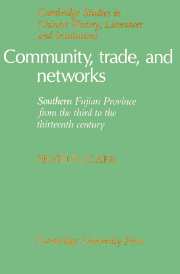Book contents
- Frontmatter
- Contents
- List of maps and tables
- Acknowledgments
- 1 Problems and approaches
- 2 The late Tang
- 3 The interregnum: politics, structure, and administration
- 4 The interregnum: society and economics
- 5 The Song: demography and networks
- 6 The Song: trade and economy
- 7 Conclusions
- Appendix 1 Townships (xiang), villages (li), and command brigades (dubao) under the Song
- Appendix 2 A discussion of population distribution
- Appendix 3 Pre-Song and Song bridges by district in twenty-five-year intervals
- Appendix 4 Place names in the Yunlu manchao and Zhufan zhi
- Appendix 5 Abbreviations
- Notes
- Glossary
- Bibliography
- Index
2 - The late Tang
Published online by Cambridge University Press: 13 October 2009
- Frontmatter
- Contents
- List of maps and tables
- Acknowledgments
- 1 Problems and approaches
- 2 The late Tang
- 3 The interregnum: politics, structure, and administration
- 4 The interregnum: society and economics
- 5 The Song: demography and networks
- 6 The Song: trade and economy
- 7 Conclusions
- Appendix 1 Townships (xiang), villages (li), and command brigades (dubao) under the Song
- Appendix 2 A discussion of population distribution
- Appendix 3 Pre-Song and Song bridges by district in twenty-five-year intervals
- Appendix 4 Place names in the Yunlu manchao and Zhufan zhi
- Appendix 5 Abbreviations
- Notes
- Glossary
- Bibliography
- Index
Summary
The late Tang dynasty is considered a major demarcation in China's history. Following the turmoil of the mid-eighth century occasioned by the rebellion of An Lushan, great changes began to sweep through China's social, political, and economic structure as new families gained access to power, new relationships between the center and the provinces were defined, and a new role was established for open, lightly regulated market exchanges. One manifestation of radical change was the growing role of the South – loosely defined to include everything from the Yangtze valley and below and often referred to by the embracing term Jiangnan – in national affairs. This development has long been recognized; perhaps the clearest early statement was that of Kuwabara Jitsuzō in his landmark work of the 1920s.
Quannan was to remain on the periphery of civilization throughout the Tang, yet the confusion of changing names summarized at the end of the preceding chapter reflected a major change in perception. Clearly an area that had once been considered not just peripheral but even beyond the pale was now acknowledged to be part of China. The establishment in 699 of a prefecture centered in the valley of the Jin River and including the adjacent valleys of the Jiulong and Mulan rivers was a tentative expression of inclusion. Perhaps significantly, the dynasty, then at the height of its power and glory, gave the new prefecture a name – Wurong – that can be translated “martial splendor,” reflecting the great and spreading power of the empire.
- Type
- Chapter
- Information
- Community, Trade, and NetworksSouthern Fujian Province from the Third to the Thirteenth Century, pp. 19 - 37Publisher: Cambridge University PressPrint publication year: 1991

